Treasury Rate Movements, August 2019
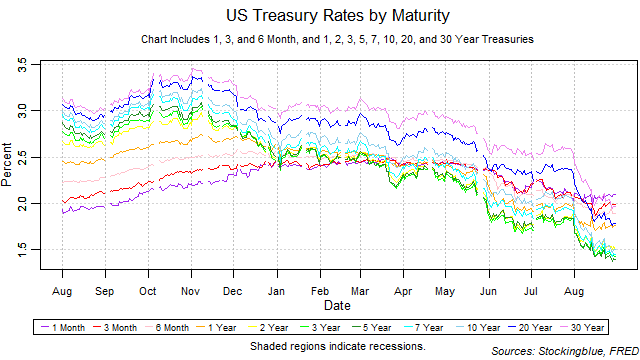
All rates except for the one-month bill fell in August. The yield curve narrowed from the previous month thus extending its narrowing streak to two months. The one-month bill did not maintain the lowest rate at any point in the month but did hold the highest rate on several sessions. Long-term rates fell at an equal or faster pace than short-term rates, to such a degree that an inversion brought upon by rising short-term rates occurred. Such an inversion is a strong indicator for an upcoming recession.
EU Long-Term Interest Rates, June 2019
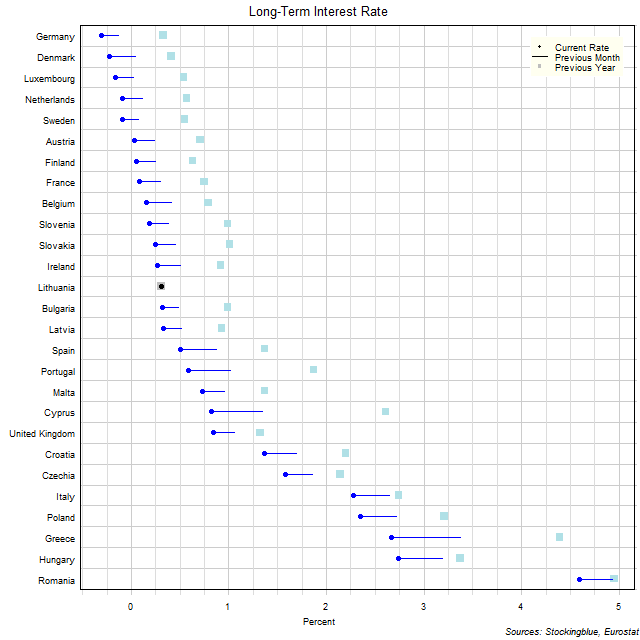
The chart above shows the ten-year interest rate in each EU state as of June 2019, the change from the previous month, and the rate one year prior. Five states have a negative interest rate.
Treasury Rate Movements, July 2019
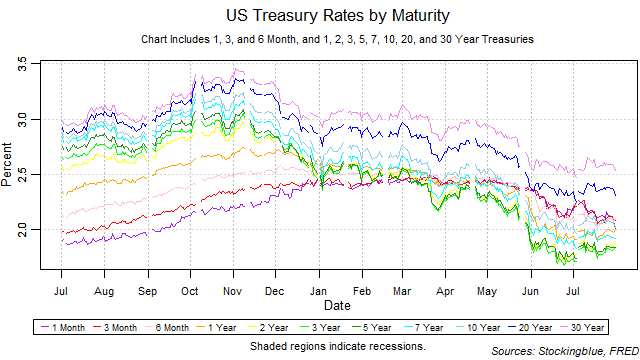
All rates except for the one and three-month bills rose in July. The yield curve narrowed from the previous month thus ending its one month widening streak. The one-month bill did not maintain the lowest rate at any point in the month. Long-term rates rose at an equal or faster pace than short-term rates thus decreasing the risk of an inversion brought upon by rising short-term rates. Such an inversion, if it were to happen would be a strong indicator for an upcoming recession. A side note: several financial analysts have recently pointed to inversions between particular rates like the three-year note having a higher rate than the five-year note as being indicators for a recession. The data does not back this up. The only type of inversion that has led to a recession reliably is one in which the highest rate is a shorter-term treasury than the lowest rate. This is the only inversion that has predicted a recession seven out of eight times since 1962. According to this measure, there is no recession in the foreseeable future.
EU Long-Term Interest Rates, May 2019
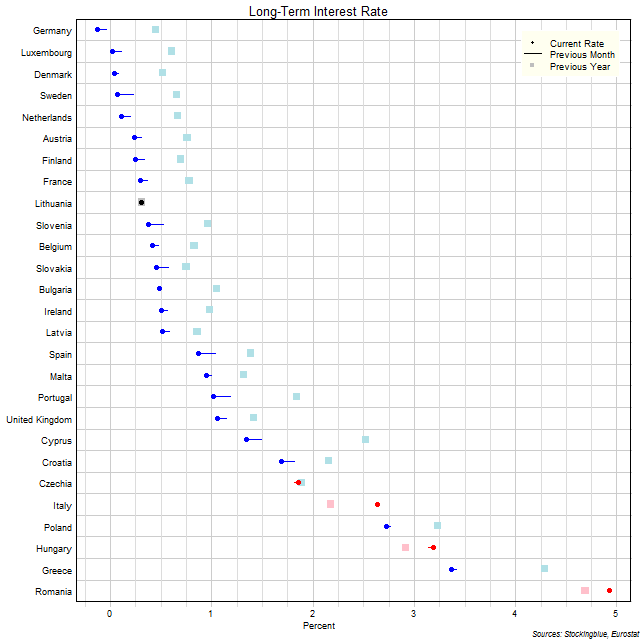
The chart above shows the ten-year interest rate in each EU state as of May 2019, the change from the previous month, and the rate one year prior. Germany continues to be the only state with a negative interest rate.
Treasury Rate Movements, June 2019

All rates fell in June. The yield curve widened from the previous month thus ending its one month narrowing streak. The one-month bill did not maintain the lowest rate at any point in the month. Long-term rates fell at a slower pace than short-term rates thus decreasing the risk of an inversion brought upon by rising short-term rates. Such an inversion, if it were to happen would be a strong indicator for an upcoming recession. A side note: several financial analysts have recently pointed to inversions between particular rates like the three-year note having a higher rate than the five-year note as being indicators for a recession. The data does not back this up. The only type of inversion that has led to a recession reliably is one in which the highest rate is a shorter-term treasury than the lowest rate. This is the only inversion that has predicted a recession seven out of eight times since 1962. According to this measure, there is no recession in the foreseeable future.
EU Long-Term Interest Rates, April 2019
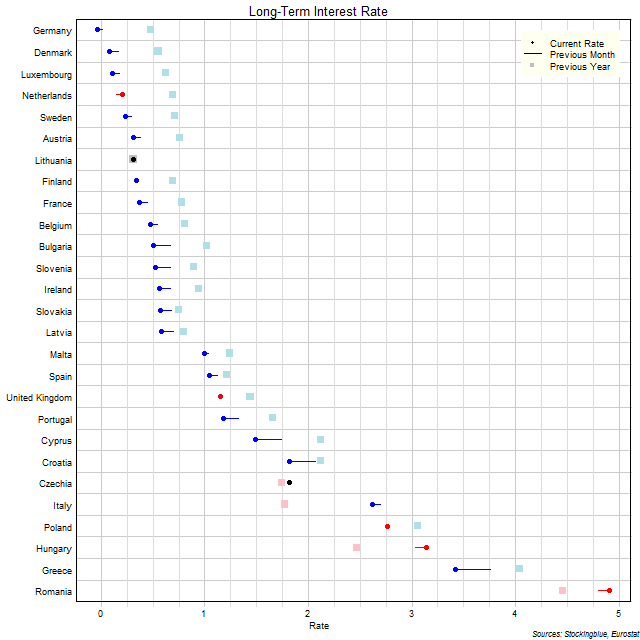
The chart above shows the ten-year interest rate in each EU state as of April 2019, the change from the previous month, and the rate one year prior. Germany is the only state with a negative interest rate.
Treasury Rate Movements, May 2019

All rates fell in May. The yield curve shrank from the previous month thus ending its one month widening streak. The one-month bill did not maintain the lowest rate at any point in the month. Long-term rates fell at a faster pace than short-term rates thus increasing the risk of an inversion brought upon by rising short-term rates. Such an inversion, if it were to happen would be a strong indicator for an upcoming recession. A side note: several financial analysts have recently pointed to inversions between particular rates like the three-year note having a higher rate than the five-year note as being indicators for a recession. The data does not back this up. The only type of inversion that has led to a recession reliably is one in which the highest rate is a shorter-term treasury than the lowest rate. This is the only inversion that has predicted a recession seven out of eight times since 1962. According to this measure, there is no recession in the foreseeable future.
Treasury Rate Movements, April 2019
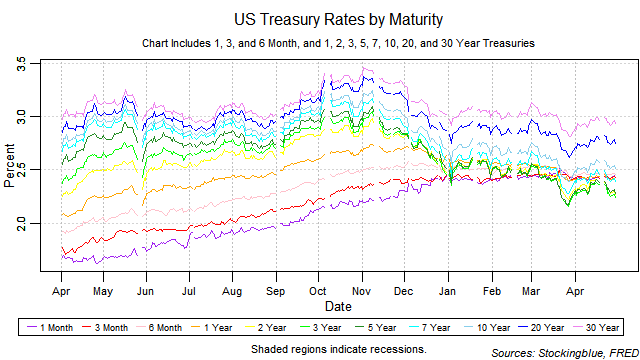
All rates except for the one-year bill rose in April. The yield curve grew from the previous month thus ending its one month narrowing streak. The one-month bill did not maintain the lowest rate at any point in the month. Long-term rates rose at a faster pace than short-term rates thus neutralizing the risk of an inversion brought upon by rising short-term rates. Such an inversion, if it were to happen would be a strong indicator for an upcoming recession. A side note: several financial analysts have recently pointed to inversions between particular rates like the three-year note having a higher rate than the five-year note as being indicators for a recession. The data does not back this up. The only type of inversion that has led to a recession reliably is one in which the highest rate is a shorter-term treasury than the lowest rate. This is the only inversion that has predicted a recession seven out of eight times since 1962. According to this measure, there is no recession in the foreseeable future.
Treasury Rate Movements, March 2019
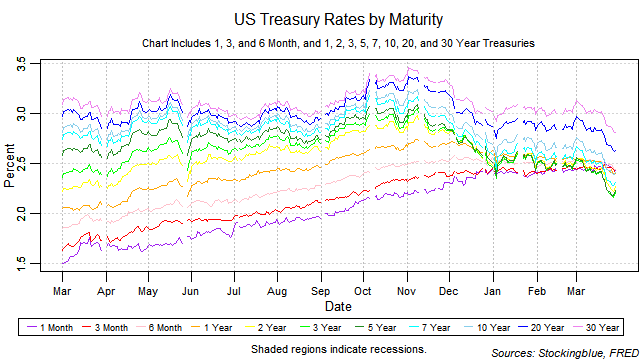
All rates dropped in March. The yield curve shrank from the previous month thus ending its one month widening streak. The one-month bill did not maintain the lowest rate throughout the month. Long-term rates fell at a faster pace than short-term rates thus neutralizing the risk of an inversion brought upon by rising short-term rates. Such an inversion, if it were to happen would be a strong indicator for an upcoming recession. A side note: several financial analysts have recently pointed to inversions between particular rates like the three-year note having a higher rate than the five-year note as being indicators for a recession. The data does not back this up. The only type of inversion that has led to a recession reliably is one in which the highest rate is a shorter-term treasury than the lowest rate. This is the only inversion that has predicted a recession seven out of eight times since 1962. According to this measure, there is no recession in the foreseeable future.
Treasury Rate Movements, February 2019
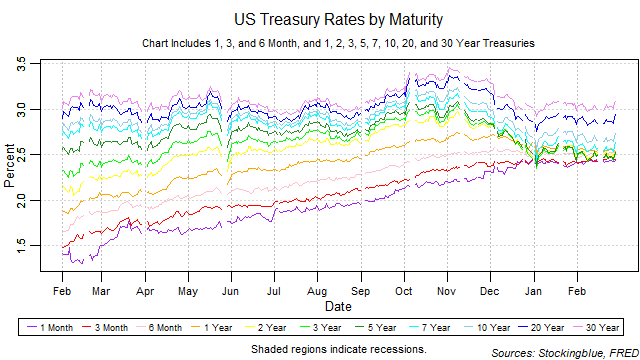
All rates except for the one-year rose in February. The yield curve rose from the previous month thus ending its even streak of one month. The one-month bill did not maintain the lowest rate throughout the month. Long-term rates rose at a faster pace than short-term rates thus neutralizing the risk of an inversion brought upon by rising short-term rates. Such an inversion, if it were to happen would be a strong indicator for an upcoming recession.
OlderNewer